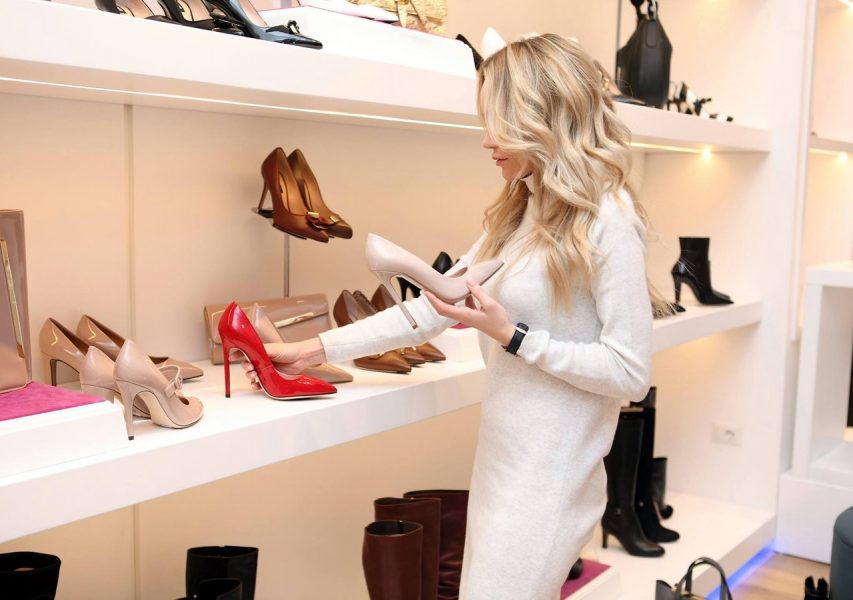Over the last few years, footwear has become an increasingly important category in retail where clothing has always reigned. Yes, shoes have always had their own industry and purpose, however they are now being integrated more than ever before into apparel brands and stores. Because of this, retailers now how to consider how to merchandise their footwear among their apparel to help drive sales.
Here are some tips on how display your footwear and improve your profits.
Let’s cover two things:
1) The basics: getting the basics right is the beginning point of anything.
2) Factors that influence how footwear should be displayed
The combination of these points will help merchandise your footwear and drive profitability.
Sample shoe presentation
THE DO’S AND DONT’S OF A SHOE DISPLAY
First and foremost, the shoes need to appeal to shoppers. Here are the A, B, and C of presentation:
- Ensure the item is clean. Regularly lift the and remove dust.
- Fill the shoe but not over or under stuffed.
- Have a good system to display the purchase price and what sizes are available.
- Make sure when that once the shoe on display is purchased another comes to replace it.
- Ensure your display shoes are the appropriate size (9 for men and 7 for women).
- If you stock big sizes (14-18), give them their own space on the footwear wall. You may sell more that way!
- If you don’t have enough styles to fill the whole wall, double expose your best-selling styles.
- Make sure laces on lace up sandals are neat and not falling over the edge
- All display shoes should be lined up vertically and horizontally, columns and rows
- Ensure the shelves, walls and display showcases are cleaned regularly.
Footwear walls — position in your store

The positioning of your footwear display inside your shop is ideally at a neutral zone. This means men’s shoes, women’s shoes and children’s shoes can be displayed together. As an additional benefit, this doesn’t polarise a specific consumer group and is particularly important when there’s a strong tendency in unisex sizing. (For instance; Vans Authentic, Converse Chuck Taylor).
Ultimately, you’re the one who knows your business. If you mostly promote men’s footwear it may make more sense to have it near the men’s apparel. You’ve got to use common sense. I did go to a shop that had their men’s footwear range at the conclusion of the women’s apparel. Funny enough, they told me men’s footwear was not that powerful for them…
Footwear walls — slat wall / shelving
Another debated subject is slat-wall verses shelving verses custom showcases.
Some have tried other ‘fancy new systems’. I’ve seen cubes, things hanging from ceilings etc. but the old slat wall or a shelving system is best every time. Keep things simple.
Slat wall lets you display shoes in a neat and uniform manner. Everything has a place and if you find a gap, then you fill it. Additionally, it means that you can leverage the power of brand shelf-talkers.
Shelves are great as they allow very good space to work from. When SKU’s are expanding or retracting because of sale volume or seasonal change, shelving means it is easy to re-organise things
Last, lighting is extremely important to your footwear screen. The goal with light is to emphasize an object so that the customer is going to want to buy it. Have new season gold heels that need extra attention? Then cast a spotlight on them to attract shoppers.
It’s also important to consider seasonal trends, for example, in spring racing season it would be strategic to place emphasis on race day heels as there are likely to be many shoppers looking to purchase some.
Footwear walls — ‘hot’ and ‘cold’ space
The last important factor to mention is hot and cold spaces on a footwear wall (shelves too).

The most uniform and logical method to sort a wall would be by style or brand. In some stores, the styles are relatively similar so in that case it is best to go by brand. In contrast Footlocker, has casual, running, basketball and coaching classes and therefore groups it goods by those categories. To set up your wall you will need to rank brands by whichever metric is important to your company. The shoes and brands that get you the most business should be the centre of attention. That is, in the centre of the wall or display and at eye level – that way they are the first spot where a person’s eyes focus when entering the store.
Storage
Storage is important because if your staff need to go out back and keep the customer waiting, that is not very good service and it costs you money! Second, if they return and cannot find what the shopper desires, a sale is lost and it cost you money! Thirdly, footwear boxes are bulky and if stored improperly may, literally, cost you money.
I recently was shoe shopping and the time management in a Melbourne store was second to none. The staff clearly had a good system for displaying and storing the shoes and as such they could efficiently serve their customers.
Customers hate walking into a store to see half-empty displays. Not only does it look messy and lazy, but there are less products for the customer to browse and potentially purchase.
One of my pet peeves is when the exhibit shoe is sold and not replaced with another. Some customers may even walk out as a result, a well-organised room can help this from happening. Ideally, keeping brands and then styles together, in size order, is the best thing to do.
In case you have singles left over that are being pulled out of the wall and kept available at a later date, then store them in another place all together.
Maintaining the back room organised is your starting point to getting an organised footwear wall. An organised back room increases worker productivity and the time it takes employees to locate shoes and serve customers.
Shoppers have high expectations on how products are presented in shop. You cannot expect them to let you know once you have nailed it, but one fact is for sure, they’ll remember something which is presented to them badly.
Footwear is a significant part of the retail industry, therefore spending some time on getting it right important to raise profitability.
